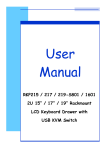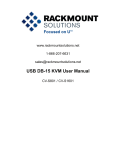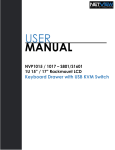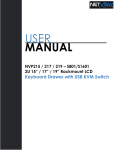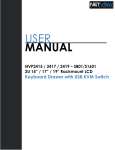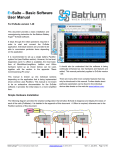Download Eusso 8-Port User`s manual
Transcript
4 port / 8 port / 16 port 19” RACK MOUNTABLE USB KVM SWITCH USER’S MANUAL Rev 1.0 TABLE OF CONTENTS TABLE OF CONTENTS………………………………………………..1 INTRODUCTION……………….……………………………………..2 FEATURES…………...……………………………………………….2 PACKAGE CONTENTS…………………………………………….3 TECHNICAL SPECIFICATIONS………..……………………………4 SYSTEM REQUIREMENT…………………………………………..5 CABLE DIAGRAMS………………………………………………….6 PRODUCT DETAILS…………………………………………………6 MAC O.S. and Sun Micro Systems Keyboard Mapping………6 HARDWARE INSTALLATION………………………………………7 USAGE…………………………………………………………………10 DAISY CHAIN CONNECTION DIAGRAM…………………………14 HOT PLUG……………………………………………………………15 ON SCREEN DISPLAY OPERATION……………………………15 TROUBLESHOOTING………………………..………………………21 CERTIFICATIONS……………………………………………………22 1 Introduction Thank you for purchasing USB KVM switch. 19” Rack Mount USB KVM switch can save your MONEY, TIME, SPACE, EQUIPMENT and POWER. Controlling multiple USB computers from One USB Keyboard, USB Mouse and VGA Monitor. Rack Mount USB KVM switch is loaded with features such as 19” Rack Mount Size, Daisy Chain up to Eight units, On Screen Display Menu, Password security, Searching PC server name, Hot key Control, Push Button and Auto Scan Control. It has complete keyboard and mouse emulation for simultaneous PCs boot-up process. Features 4/8/16 port USB KVM switch is 19” rack mount size design USB 1.1 Specification compliant Support UHCI, OHCI USB interface Support Win98/98SE/ME/2000/XP, WinNT, HP Unix, Linux, Sun Solaris, MAC O.S 8.6 or later version Manage multiple PCs, G3/G4 MACs, iMACs, SUN Microsystems with USB port from one USB keyboard, USB Mouse and Monitor. Hot Plug - Add PCs or Remove Connected PCs for Maintenance without Powering Down the KVM switch or PCs. Very High Video Quality - Up To 1920X1440, Bandwidth: 200MHz No Software Required - easy PC selection via On Screen Display Menu, Push Buttons, Hot Keys Support eight characters password protection and search PC server name Plug N Play, No software driver needed for USB keyboard and USB mouse operation. Auto Scan Mode for monitoring PCs and flexible Scan time from 5~99 seconds Keyboard status restored when switching PCs Support VGA DDC, DDC2, DDC2B. LED Display for easy status monitoring Buzzer sound for switching port confirmation. Using 2-in-one cable (HDDB 15 pin male to HDDB 15 pin male and USB type A plug) Built-in one extra daisy chain port and no waste any PC port No DIP switch setting needed and auto detect daisy chain bank 2 Package Contents Model No.: 4 port Rack Mount USB KVM Switch 4 port USB KVM Switch 1 PCS User’s manual 1 PCS AC to DC Power Adapter 1 PCS Rack Mount Kit 1 SET Daisy Chain Cable 1 PCS 2-in-one PC port cable 4 PCS Model No.: 8 port Rack Mount USB KVM Switch 8 port USB KVM Switch 1 PCS User’s manual 1 PCS AC to DC Power Adapter 1 PCS Rack Mount Kit 1 SET Daisy Chain Cable 1 SET 2-in-one PC port cable 4 PCS Model No.: 16 port Rack Mount KVM Switch 16 port USB KVM Switch 1 PCS User’s manual 1 PCS AC to DC Power Adapter 1 PCS Rack Mount Kit 1 SET Daisy Chain Cable 1 SET 2-in-one PC port cable 4 PCS 3 Technical Specifications Model No. 4 port Rack Mount USB KVM Switch 8 port Rack Mount USB KVM Switch 16 port Rack Mount USB KVM Switch 4 8 16 1 1 1 PC Port Console Port PC Port Connector (All Female Types) VGA HDDB 15pin ( shared with USB port ) Console Port Connector (All Female Types) USB Keyboard USB-A type USB Mouse USB-A type VGA HDDB 15pin Daisy Chain Port Connector VGA HDDB 15pin (All Female Types) PC selection On Screen Display Menu, Hot Key, Push Button PC Port LED 4 8 Bank 7 segment LED On Screen Display Control 1 Yes Scan Intervals 5~99 Sec. Keyboard Emulation USB Mouse Emulation USB VGA Resolution 1920X1440 Bandwidth 200MHz Daisy Chain MAX Level 8 MAX PC Connection 116 120 Housing Metal Power Adapter DC 12V 1A Operation Temperature 0~50℃ Storage Temperature -20 ~ 60℃ Humidity 0~80%, Non-Condensing Size 19” Rack Mount / 1RU Weight (kg) Dimension (cm) 16 19” Rack Mount / 1RU 1.9 2.0 128 19” Rack Mount/ 1RU 2.2 41(L) X 16.5(W) X 4.4(H) 41(L) X 16.5(W) X 4.4(H) 41(L) X 16.5(W) X 4.4(H) 4 System Requirements Specifications: Model No. Console side Computer side Model No. Console side Computer side Model No. Console side Computer side 4 port Rack Mount USB KVM Switch One VGA Monitor One USB Keyboard One USB Mouse 4 HDDB 15 pin male to one HDDB 15 pin male and USB type A plug 4 pin special cables 8 port Rack Mount USB KVM Switch One VGA Monitor One USB Keyboard One USB Mouse 8 HDDB 15 pin male to one HDDB 15 pin male and USB type A plug 4 pin special cables 16 port Rack Mount USB KVM Switch One VGA Monitor One USB Keyboard One USB Mouse 16 HDDB 15 pin male to one HDDB 15 pin male and USB type A plug 4 pin special cables 5 Cable Diagrams PC Port Special Cable: HDDB15 pin Male to One HDDB 15 pin male and USB type A plug 4 pin special cable Daisy Chain Cable: HDDB15 pin Male to Male Product Details Front Panel & Rear Panel of 4 port Rack Mount USB KVM Switch: Front Panel & Rear Panel of 8 port Rack Mount USB KVM Switch: Front Panel & Rear Panel of 16 port Rack Mount USB KVM Switch: MAC O.S. and Sun Micro Systems Keyboard Mapping The following diagram indexes the Hotkey combination that emulates Mac O.S. and Sun Micro keyboard commands. This feature is only available on the USB keyboard. Left Windows Key = L_Win 6 Sun Microsystems Keyboard Stop Props Compose Front Open Find Again Undo Copy Paste Cut Help Power Mute V_DN V_UP Windows ps2 Keyboard L_Win & L_Alt L_Win & L_Ctrl L_Win & L_Shift L_Win & F1 L_Win & F2 L_Win & F3 L_Win & F4 L_Win & F5 L_Win & F6 L_Win & F7 L_Win & F8 L_Win & F11 L_Win & F12 L_Win & "1" L_Win & "2" L_Win & "3" Windows Key Alt Print Screen Scroll Lock Pause Break Mac OS Power Apple Key Option F13 F14 F15 Hardware Installation Before installation, please make sure all of peripherals and computers have been turned off. This example of installation is based on 8 port USB KVM switch and you also can think that 4 port or 16 port USB KVM switch have the same installation procedures Step 1 Find a convenient place to put your USB KVM Switch. Its 19” rack mount form factor makes it ideal mountable on 19” rack. When mounting to a rack, attach the included brackets to the sides of the USB KVM Switch. Take note of the length of your cables so that your computers, USB KVM Switch, keyboard, mouse and monitor are distanced properly. Attach the power adapter which included in this package to the USB KVM unit and plug the other end into an electrical receptacle. Now you will see the LED for Port 1 light up, and you will hear a beep. 7 Step 2 Connect the monitor to the USB KVM Switch. Using the attached cable, or the one included with your monitor, connect it to the HDDB-15 female port on the back of the USB KVM unit labeled with the monitor symbol at the CONSOLE port connector. Note: For Windows ME/XP/NT/2000 user, please skip step 3 and go to Step 3-1 directly. Step 3 For Windows 98/98SE/DOS user only: Connect PS/2 keyboard to your PC PS/2 keyboard port directly and do not connect PS/2 mouse to your PC Step 3-1 For Windows ME/XP/NT/2000 user only: Connect USB keyboard to your PC USB keyboard port directly and do not connect PS/2 mouse to your PC Step 4 Please connect the USB mouse to the USB KVM Switch’s USB mouse port. Step 5 Now the PC connections will be made with the monitor (VGA) connections first. Connect a 2-in-one cable (15-pin HDDB Male to 15-pin HDDB Male and USB type A) with the VGA male side to both of the PC and the rear panel of the USB KVM switch to the connector labeled VGA. 8 The rear side of PC Step 6 Connect 2-in-one cable (15-pin HDDB Male to 15-pin HDDB Male and USB type A) USB type A side cable to the PC. The rear side of PC Step 7 Windows 98/98SE user: When you apply Windows 98/98SE to USB KVM Switch, please use the following set up procedure: 1. Boot the PC and PC is unable to get the mouse during boot up system. The Window O.S. will show the following message or similar things: " Windows did not detect a mouse attached to the computer. You can safely attach a serial mouse now. To attach a mouse to a PS/2 mouse port, you must first turn the computer off. □ Do not show this message in the future. " Please use keyboard "Tab" key, "Space" bar and "Enter" key to select the item " □ Do not show this message in the future." and finishing booting Windows O.S.. 2. It will mount USB HID (Human Interface Device) driver. Using Keyboard “Tab” key, “Left Arrow” key, “Right Arrow” key and “Enter” key to accomplish set up process. 3. Please turn off USB KVM Switch and use Windows key “ “ to shut down computers. DOS User: If the motherboard BIOS' USB port is disable in default mode and you apply USB keyboard or USB mouse to PC. It does not work in DOS mode. Please disconnect USB keyboard or USB mouse and connect PS/2 keyboard to the PS/2 port of PC for enabling BIOS USB port. Different motherboard BIOS has different USB port set up procedure. Here are some examples, which based on some kind of BIOS version, below for the user reference. 9 A. AWARD BIOS: To press "Del" key immediately for a couple of times when powering on PC and you will get into BIOS set up mode→Select "Advanced" item →USB Legacy support→Select "AUTO" →Save and quit BIOS set up. B. PHOENIX BIOS:To press "F2" after powering on PC gets into BIOS set up mode→ Select "Advanced" item→Legacy USB support→Select "Enable" → Save and quit BIOS set up. C. AMI BIOS:To press "Del" key immediately for a couple of times when powering on PC and you will get into BIOS set up mode → Select "Chipset features setup" → USB controller→all USB port USB KB/Mouse→ KEYB+MOUSE → Save and quit BIOS set up. Note: If the PC BIOS need check keyboard to accomplish boot up process and the PC might show keyboard error message on the screen, please configure the BIOS setting again. When you enter BIOS set up mode, please select the item “Halt on Error” or the other Error condition setting and select “Halt all errors but Keyboard” or to ignore keyboard during boot up BIOS process. Step 8 1. For Windows 98/98SE/DOS user, Please repeat step 3 to 7 for the remainder of the computers. 2. For Windows ME/XP/NT/2000 user, Please repeat step 3-1 to 6 for the remainder of the computers. Step 9 Connect the USB Keyboard to the USB KVM Switch. Note: For MAC or Sun Microsystems user, please follow up the similar installation procedure like Windows ME/XP/NT/2000. Usage The power on state of 4/8/16 port KVM switch: When you power on KVM switch, it will ask you the password, the default password value is eight zero –“ 00000000 “. Please key in eight zero and enter the same value at retype field. Note: Before you are not familiar with the operation of OSD menu, please don’t change the password – i.e. keep default eight zero (00000000) value. Otherwise, if you have set the password and unfortunately forget the password, you need send it back to your distributor for maintaining the password. 10 Pressing BANK Button to change BANK, and each BANK button assigns the channel to designated PORT. The LED display shows the Power On PC. 4 port Rack Mount USB KVM Switch The Push Buttons : Pressing the individual button to get PC port you want. Reset Button ( (“ Bank ” button) and (“ PC 4 ” button ) ): To press both “PC 4 ” button and “ Bank ” button of master bank simultaneously can reset KVM switch. This reset action will not only return KVM switch back to initial state --- Check the password, but also re-check all of slave banks which connected to mast KVM Switch. If you add a new KVM Switch as a slave bank, please use reset button of master KVM Switch to automatically assign a new ID to it. You can view this new slave bank go through OSD menu. The PC ports of KVM Switch does not be reset by reset command. PC port LED Indication: There are two LEDs--- Power LED (The LED is marked by “ P “) and Link LED (The LED is marked by “ O “) accompanied with each PC port. When you select one of four PC ports and this PC is shut down or this PC port is disconnected to the PC, the selected power port LED is off (But, if this PC is PC99 type, the selected power port LED is lit) and the Link LED is flash. When you select one of four PCs ports and this PC is powered on, the selected port Link LED is lit. 8 port Rack Mount USB KVM Switch The Push Buttons : Pressing the individual button to get PC port you want. Reset Button ( (“ Bank ” button) and (“ PC 8 ” button ) ): To press both “PC 8 ” button and “ Bank ” button of master bank simultaneously can reset KVM switch. This reset action will not only return KVM switch back to initial state --- Check the password, but also re-check all of slave banks which connected to mast KVM Switch. If you add a new KVM Switch as a slave bank, please use reset button of master KVM Switch to automatically assign a new ID to it. You can view this new slave bank go through OSD menu. The PC ports of KVM Switch does not be reset by reset command. PC port LED Indication : There are two LEDs--- Power LED (The LED is marked by “ P “) and Link LED (The LED is marked by “ O “ ) accompanied with each PC port. When you select one of eight PC ports and this PC is shut down or this PC port is disconnected to the PC, the selected power port LED is off (But, if this PC is PC99 type, the selected power port LED is lit) and the Link LED is flash. When you select one of eight PCs ports and this PC is powered on, the selected port Link LED is lit. 16 port Rack Mount USB KVM Switch The Push Buttons : Pressing the individual button to get PC port you want. To press both “ Shift “ button and port 1(or port 2, 3,4,5,6,7,8) individual button 11 simultaneous to get PC port 9 (10,11,12,13,14,15,16) respectively. For example: The user would like to switch console port to PC port 12. He can press “ Shift “ button and port 4 button simultaneously. The port LED of PC port 12 is lit when the console is switched to PC port 12. Reset Button ( (“ Bank ” button) and (“ PC 8 ” button ) ): To press both “PC 8 ” button and “ Bank ” button of master bank simultaneously can reset KVM switch. This reset action will not only return KVM switch back to initial state --- Check the password, but also re-check all of slave banks which connected to mast KVM Switch. If you add a new KVM Switch as a slave bank, please use reset button of master KVM switch to automatically assign a new ID to it. You can view this new slave bank go through OSD menu. The PC ports of KVM Switch does not be reset by reset command. 16 port Rack Mount USB KVM Switch (16 Ports) PC port LED Indication : There are two LEDs--- Power LED (The LED is marked by “ P “) and Link LED (The LED is marked by “ O “ ) accompanied with each PC port. When you select one of sixteen PC ports and this PC is shut down or this PC port is disconnected to the PC, the selected power port LED is off (But, if this PC is PC99 type, the selected power port LED is lit) and the Link LED is flash. When you select one of sixteen PCs ports and this PC is powered on, the selected port Link LED is lit. Note: If there are one of rack mount of KVM switches you used is 16 port USB KVM switch, please put 16 port USB KVM switch on the 1st bank ( or say Master bank). It is based on 16 port USB KVM switch supports 16 port LEDs display on the front panel. Otherwise, 4 port or 8 port USB KVM switch is allocated at 1st bank and there is a 16 port USB KVM switch chained to the slave bank, the master bank ( or say 1st bank ) is unable to show the PC port LEDs ( from port 9 to 16 ) of 16 port USB KVM switch completely. 7-Segment BANK LED Indication When you would like to view the next bank KVM switch, please press “ BANK “ push button cyclically to the destination bank. The bank LED will be changed from bank 1 to the maximum daisy chain level and then to press “ BANK “ push button once back to the bank 1. Bank 1 Bank 2 Bank 3 MAX BANK Keyboard Hot Key Commands: You can also conveniently command KVM switch by switching ports through simple key sequences. To send commands to KVM switch, the “SCROLL LOCK” key must be pressed twice within 2 seconds. You will hear a beep for confirmation and the keyboard is in hot key mode. If you have not pressed any key in hot key mode within 2 seconds (It means to key in any key follows up “Scroll Lock” “Scroll Lock” key ), the keyboard will back to under Operation System control state. 12 Below are the different hot key commands: within 2 seconds Scroll Lock + Scroll Lock + ↑ = Previous Power On Channel (PC is Power On) Scroll Lock + Scroll Lock + ↓ = Next Power On Channel (PC is Power On) (Note: You also could press “up arrow key” or “down arrow key” longer time to speed up selecting the destination port) Scroll Lock Scroll + Lock + Scroll Lock + Page Up = Previous Bank (PC is power on) + Scroll + Lock + Page Down = Next Bank (PC is power on) To select PC port: Scroll Lock Scroll Lock + + Scroll Lock Scroll Lock + + Bank 1~8 B Port No. 1~4 (4 port) 1~8 (8 port) 1~16 (16 port) Port No 0 or 1 = Beeper (Note: The default Beeper function is ON and beeper control is only for available for Scan Mode ) Scroll Lock + Scroll Lock + S = Auto Scan (Note: This function is just for power on PC PORT ) To get out of Auto Scan Mode, Press any key or SPACE bar. Scroll Lock + Scroll Lock + Scroll Lock + Scroll Lock + R = OSD setting back to factory default value (Note: Not including password) Space Bar = On Screen Display Menu 13 Example: A. To access a computer attached to Port 4 of the third Bank. You can press through hot key as below: Scroll lock + Scroll lock + 3 + 04 B. To access a computer attached from Bank 3 to Bank 4, You can press through hot key as below: Scroll lock + Scroll lock + Page Down Note: Bank no. and Port no. selection must be made using the numeric keys on the keyboard. Numeric keys on the keypad are not available as a hot key command. Daisy Chain Connection Diagram Please use the attached 3 feet VGA daisy chain Cable Kit to daisy chain the KVM Switch and plug-in Power Adapter (12V 1A) into every KVM switch before daisy chaining other KVM switch. A. Connect Keyboard, Mouse and Monitor to the console port (silver color block) of bank 1 KVM switch. B. Use one end of daisy chain Cable Kit to connect the daisy chain port of bank 1 and the other end for the console port (silver color block) of bank 2 KVM switch. C. Please repeat item B to daisy chain more bank as you want. But, the maximum daisy chain bank is eight levels. 14 Hot Plug The USB KVM Switch supports “Hot Plug“ function for easy addition or removal of PCs. On Screen Display Operation On Screen Display provides a menu driven interface to handle a computer switching process, to name a PC name or server name, to set up the password/window display time and to search PC port name if you don’t remember it. Note: When using the keyboard arrow key to move the cursor, the keypad arrow key (Up, Down, Right, Left) is unable to work at this menu. When you pop up the OSD menu window through the hot key, you will see the “MAIN CONTROLS” window on your monitor as below. There are two ways, keyboard and mouse, to operate the on screen display. Keyboard Operating: In MAIN CONTROLS window, use the Up “©” or the Down ”ª” Key to select a category and press Enter”” Key to get into designated option. Pressing “F1” Key brings up HELP window and Esc key to exit. Mouse Operating: You may also simply use mouse, twice clicking left button, to choose a category. Clicking “?” will bring up HELP window and click “X” for exiting. 15 MAIN CONTROLS ?X ENTER A CHOICE : 01 LANGUAGE 02 PORTNAME 03 TIMEVIEW 04 SECURITY 05 FINDPORT 06 PASSWORD 07 CONSOLE Once you use keyboard or mouse to move the highlight bar cursor to “ PORTNAME “ to press [Enter] key or double clicks “ PORTNAME “ to activate “ PORTNAME ” window. The other items like “ LANGUAGE ”, “ TIMEVIEW “, “ SECURITY “, “ FINDPORT “, “ PASSWORD “, and “ CONSOLE “ need be activated in the same way. PORTNAME OSD Window : PORTNAME BANK ?X 1 01 SYSTEM 01 02 ☼ SYSTEM 02 03 SYSTEM 03 04 SYSTEM 04 05 SYSTEM 05 06 SYSTEM 06 07 SYSTEM 07 08 SYSTEM 08 09 ☼SYSTEM 09 a. The 1ST line bar is Bank no. b. The 2nd block is your PC system name list. You will find the system number list from 01 to 04 (if the current box is 4 port) or from 01 to 08 (if the current box no. is 8 port) or from 01 to 16 (if the current box no. is 16 port). You can define your PC name in maximum 10 characters. The factory default of 16 port KVM switch PC name is from “SYSTEM 01”, “SYSTEM 02” ,…, “SYSTEM 16” and 8 port KVM switch is from “SYSTEM 01”, “SYSTEM 02”,…, “SYSTEM 08”. Besides, the sun symbol “☼ “near to the PC name represents the PC system is powered on. Using the Up key “© “ or the Down key “ª“ to select port for destination PC name. After you have selected the PC port already, you can either press the ENTER Key, or twice clicking the left button of mouse to switch the PC port immediately. You can use mouse to click the triangle button, which located at the right up side or the right down side, to scroll the menu. If there are more items 16 than appear on the screen, the screen will scroll. Use “ PgUp “ key or “ PgDn” key for selecting previous or next Bank no. (or Box No.) PORTNAME BANK 01 02 03 04 ?X 1 ☼ SYSTEM SYSTEM SYSTEM SYSTEM 01 02 03 04 Press “INS” key or click the right button of mouse for editing PC name. To use “ Tab “ key to select items like BANK, TIMEVIEW, SECURITY, CONSOLE, FIND PORT…. etc. HELP OSD Window : Please operate the options in HELP window by using Esc, Enter, Insert, arrow, and Page Up/Page Down keys on your keyboard. HELP ?X ESC : QUIT ENTER : COMPLETE INSERT : EDIT © / ª / ¨ / § : SELECT PaUp / PaDn : BANK SELECT 101 ☼ SYSTEM 01 LANGUAGE OSD Window: MULTILINGUAL OSD To use Keyboard: Press © / ª to choose a language and press ENTER to save. To use Mouse: Move mouse and click the left button to choose a language, and click left key again to save. 17 LANGUAGE ?X CHOOSE A LANGUAGE : 01 ENGLISH After finishing editing, please press “Enter “key for saving information. TIMEVIEW OSD Window: To use "©" and "ª" key on keyboard or press the “INS” key, or click the right button of mouse to select and modify OSD and SCAN TIME. TIMEVIEW OSD TIME : SCAN TIME : ?X 10 SEC 10 S E C a. The “OSD: 10 SEC” means that the OSD windows display or PC system name exists 10 sec. on your monitor. You can modify it from 05 sec to 99 sec. The factory default value is 10 sec... b. The “SCAN TIME” means that scan interval from one PC port to next PC port. The default SCAN time is 10 sec and the maximum scan time is 99 sec. SECURITY OSD Window: The “CHANGE PASSWORD” is for user to avoid all PC systems to be intruded by the other person. The default password is 8 digits “ 00000000 “. SECURITY ?X ENTER PASSWORD ________ ENTER NEW PASSWORD ________ RETYPE NEW PASSWORD ________ 18 There is a “SECURITY” window shows out when you select this category in MAIN CONTROLS window. The maximum password is eight digits and there are three lines “ENTER PASSWORD”, “ENTER NEW PASSWORD” and “RETYPE NEW PASSWORD” in the window. Please follow the steps as below to modify the password. 1. First of all, you need to key-in the factory default password “00000000” in password line and press the “Enter” key. 2. Then, enter the new password you wish in next line and press the “Enter” key. 3. Retype the new password in bottom line again and press the “Enter” key for confirming your typed password is matched or not. 4. If the retyped new password has matched to the entering new password, the OSD will jump back to MAIN CONTROLS window directly. SECURITY ?X ENTER PASSWORD •••••••• ENTER NEW PASSWORD •••••••• RETYPE NEW PASSWORD •••••••• CONSOLE OSD Window : The “ CONSOLE ENABLE/DISABLE “ means to manage the console of KVM switch. If you select “ CONSOLE ENABLE “, it means that any user can use the console. If you select “ CONSOLE DISABLE “(factory default ENABLE state), it means that any user will not be allowed to use the console unless you enter the password. When you enter the password already and pass the KVM switch authentication, the CONSOLE will be set to ENABLE. After you finish using KVM switch, please don’t forget to set up CONSOLE ENABLE state to DISABLE state. CONSOLE ?X ENABLE DISABLE 19 FINDPORT OSD Window : The “FINDPORT“ option helps you to find the PC system, the name you defined in PORTNAME function, by KVM switch. Key-in PC system name and press ENTER, it will search the matching PC system and given the message for searching result. FINDPORT ENTER ?X NAME : __________ Example: a. When you key-in “SYSTEM 01” and press ENTER, if there is matching PC systems were found by KVM switch, then the window will show the PC system name “SYSTEM 01” and which BANK it belongs to. Besides, you also could key-in wild card “ * “ and combine the other characters from A~Z and 0~9 to search all of system name lists matched the same format . FINDPORT ?X BANK : 1 01 SYSTEM 01 b. If there is no particular PC system name were found, the window will show “PORTNAME NO FOUND!” message instead. FINDPORT BANK : 1 PORTNAME ?X NO FOUND ! To use “ PgUp “ key or “ PgDn” key for selecting previous or next Bank (or Box), then the window will show matching PC system name or PORTNAME NO FOUND message at other BANK (or Box). 20 When you finish the set up of PC name and get out of OSD setting mode, you will find the PC name showed at the up-left corner of monitor. Now, you can use ESC key to clear the message right away if you don’t need it. Troubleshooting Ensure that all cables are well seated. Label all of cables with the number for each respective computer to avoid confusion. IBM PC or Compatible: Keyboard or mouse dose not work or not be compatible with the PC, please make sure the keyboard or mouse works when directly plug into the computer. If the problem persists, please try another keyboard or mouse. Mouse doesn’t work in Auto Scan mode, you can press any key on the keyboard or the front button on the face plate for returning standard mode and then use the Keyboard or Mouse again. When USB KVM switch is in Auto Scan mode, there are only VGA monitor display and CPU alternately ( but the USB Hub is not switched in auto scan mode ). After you press any key, the PC port will be selected at the same time, as you see the current PC Screen. If your motherboard BIOS is unable to be upgraded to new BIOS, you may need boot this PC individually and the console port need be switched to this PC before you power on this PC. The recommended VGA cable distance is 5 meters maximum without ghosting and degradation. Normally, the cable length is based on driver capacity of your VGA card. Ensure that all cables are well seated. Label all of cables with the number for each respective computer to avoid confusion. The maximum keyboard or mouse cable is 5 meters feet maximum. When you use Japanese windows OS with 106 key keyboard, there are some special keys like “¥” need 106 key driver (Microsoft native driver in O.S. CD-ROM). Please follow procedures below and click the mouse to add new driver. Win98/SE/ME: control panel → Add new hardware → Next → Next → Select "No, the device isn't in the list" → Select →"No, I want to select the hardware from a list" → Select keyboard → Select standard keyboard → Select (日本語) Japanese 106 key keyboard → Reboot PC 21 Win2000: Control panel → System → Hardware → Device manager → Keyboards → Standard keyboard → Click mouse right key → Properties → Driver → Update driver → Display a list of the known drivers → For this device so that I can choose a specific driver → Standard keyboard → Standard (日本語)Japanese 106 key keyboard → Reboot PC WinNT: Control panel → Keyboard → General → Change → Show all devices → Standard(日本語) Japanese 106 key keyboard → Reboot PC WinXP: Control panel → System → Hardware → Device manager → Keyboards → Standard keyboard → Click mouse right key → driver → Update driver → Install from a list or specific location (advanced) → Don't search. I will choose the driver to install → Deselect show compatible hardware → Standard keyboard → Standard(日本語)Japanese 106 key keyboard → Reboot PC CERTIFICATIONS FCC This equipment has been tested and found to comply with Part 15 of the FCC Rules. Operation is subject to the following two conditions: (1) This device may not cause harmful interference (2) This device must accept any interference received. Including interference that may cause undesired operation. CE – Certificate This equipment is in compliance with the requirements of the following regulations: EN 55 022: CLASS B 22 BMN006810A00 23


























